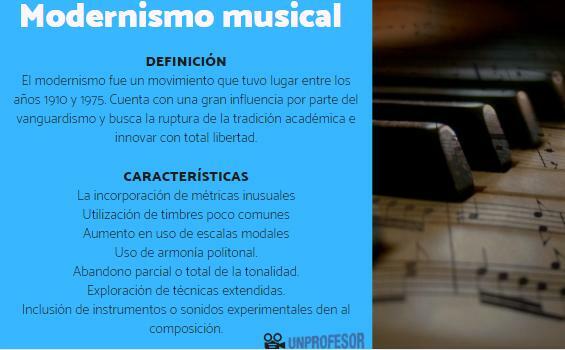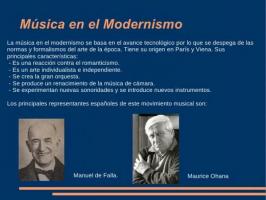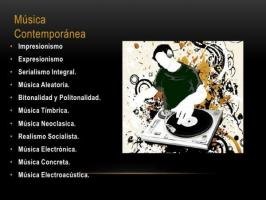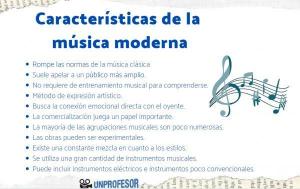7 characteristics of musical MODERNISM and most important composers

Creativity has its merit in choosing resources that already exist and using them in unprecedented ways. In music, composers play with sound, a physical phenomenon that, by understanding and studying it, has managed to manipulate it at their own pace. mercy, to create wonderful works that even within the structural parameters manage to stand out for their elements innovative. In this lesson from a TEACHER we will talk about the musical modernism: characteristics and composers a movement of vanguardism and creative freedom.
Musical modernism is a movement that took place among the years 1910 and 1975 approximately. This musical trend came after the times of romanticism and musical post-romanticism, causing the need to differentiate oneself from the factors of that moment. Modernist music would evolve to what we usually call contemporary classical music. An important observation is that Modernist music should not be confused with Modern Age music.
Modernist music has a great influence by the avant-garde
(the avant-garde movement or current) that has an experimental concept and whose main motive is to break the academic tradition and innovate with Total freedom. It is for this reason that a variety of music emerged at this time, including in turn different sub-movements or phases of development that include the following: futurism, primitivism, microtonalism, twelve-tone and serialism, neoclassicism, electronic music, random music, micro-polyphony and sonorous masses, minimalism, jazz influences and incidental music and cinematographic.
These are some of the most prominent modernist music composers. We include works as an example so you can search and listen to them.
Arnold Schönberg (1874 - 1951, Austria)
Along with Stravinsky and Prokofiev, he is considered one of the most important composers of the 20th century, since it is he who is credited with the first formal works of atonal composition. This later evolved to the genre of twelve-tone. Notable works: Transfigured Night, The Wait.
Igor Stravinsky (1882 - 1971, Russia)
Stravinsky excelled experimentally in the genres of the primitivism, neoclassicism and serialism. He was a very versatile composer, creating works of various genres and forms such as opera, symphony, solo pieces, and even jazz. He was also a pianist and conductor. The reinventions of genres such as ballet stand out in his works, breaking conventional customs in formal and social contexts. Notable works: Petrushka, The Rite of Spring, The Firebird.
Anton Webern (1883 - 1945, Austria)
He was a disciple of Schöeberg and is considered one of the most important exponents of the twelve-tone. Webern is recognized for his innovative use of the elements of height, rhythm and dynamics, organizing them to create systematic structures that eventually formed the basis of the movement of serialism. Notable works: Rosen 1975, 102.
Sergei Prokofiev (1891 - 1953, Russia)
Composer, pianist and conductor. He was very diverse in terms of the variety of musical works. He is considered one of the most important composers of the 20th century. He created 7 operas, 7 ballets, 5 piano concertos and 9 piano sonatas among many more. Notable works: The love of the three oranges, Romeo and Juliet, Peter and the wolf.
Aaron Copland (1900 - 1990, United States)
Copland has clear influences from Impressionism and Stravinsky. In addition to creating formal musical works, he also ventured into the composition of film music and became one of the most notable composers of American classical music. Notable works: Fanfare for the Ordinary Man (1942), The Tender Land (1954), Appalachian Spring (1944).
Dimitri Shostakovich (1906 - 1975, Russia)
He is strongly associated with the national affairs of the Soviet Union, sometimes causing controversy. This is just the case with his opera Lady Macbeth of Mtsensk. Many describe Shostakovich's personal style as grotesque as he uses contrasts so intensely. He composed 15 symphonies and 6 concerts in addition to composing chamber music, ballet and investigating the cinema. Notable works: Symphony No.1, Symphony No.12, Lady Macbeth of Mtsensk.
John Cage (1912 - 1992, United States)
Multifaceted artist who not only created musical works but was also a poet, philosopher, and painter. Many of his works transgress the limits of artistic areas, fusing music with acting or improvisation. Many of his works created great controversy for breaking conventional standards. Cage also blurs the line between show and interaction. He pioneered the random, electronic music and the use of unconventional instruments. Notable works: 4’33 ’’, Music of Changes, Radio Music.
As you can see, again art shows us that there are no barriers to exploring curiosity and human creativity, transgressing all conventions to continue expanding the definitions of art and expression.



